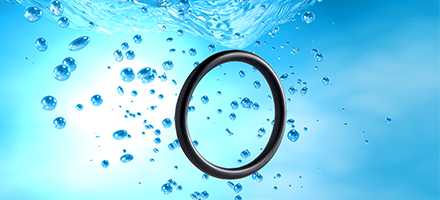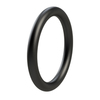O-rings
O-rings are sealing products that are mainly suitable for static applications, but they can sometimes be used in dynamic applications. However, movement can cause O-rings to twist. In these cases, we recommend using an X-ring, a double lip oil seal or a hydraulic/pneumatic seal.
When purchasing an O-ring, you need to consider the dimensions and the rubber compound used for the product.
O-ring dimensions
Our easy-to-use O-ring calculator lets you calculate the dimensions for your O-ring. These dimensions depend on the groove where the O-ring will seat (and other factors).
Our O-rings are either offered in metric sizes or according to international standards. The international standards are AS568, BS1806, ISO3601, French R, DIN3771, BS4518, JIS and DIN11864.
O-ring materials
We use various materials for the production of O-rings, such as NBR, HNBR, EPDM, FKM, FFKM and VMQ. Each material is the basis for a unique compound; a recipe of different material components that result in specific properties when combined.
It is important to ensure that the material used for your O-ring is suitable for the conditions under which it will be used. So you should always consider the medium, the temperature, the pressure and the uptime. The summary below provides concise information about the most popular materials and their properties.
- NBR O-rings
Most O-rings are made of NBR, or nitrile. This rubber material is ideal for sealing hydraulic oils or lubricating oils. NBR on the other hand is not very resistant to UV radiation, ageing and high temperatures (above +120°C).
- EPDM O-rings
EPDM is also often used as a material for O-rings. This material is well adapted to various solvents, hot water and steam. All EPDM O-rings can withstand low temperatures (down to -50°C) and are resistant to UV radiation and ageing. Some compounds are also suitable for high temperatures (up to +150°C).
- FKM O-rings
For applications that involve extremely high temperatures, an FKM O-ring, commonly referred to by the brand name as a Viton O-ring, is a good solution. This material is capable of withstanding temperatures up to +200°C. Furthermore, the standard compounds are resistant to many strong acids and bases, but not to hot water or steam. Only a few special FKM compounds are suitable for applications that involve unusually low temperatures (-40°C or lower).
- FFKM O-rings
You use FFKM O-rings for the very highest temperatures and the strongest acids, for example Kalrez O-rings. With a maximum temperature of +327°C, this material offers unbeatable performance. Like FKM seals, only special compounds of these rubber O-rings perform well in cold conditions.
- VMQ O-rings
VMQ is widely known as silicone and is very flexible. VMQ O-rings are resistant to both low (-60°C) and high (+200°C) temperatures.
- PTFE O-rings
PTFE, also known by the brand name Teflon, is highly resistant to strong acids and bases. This material is not wear-resistant, and unlike the elastomers mentioned above, also not elastic. So PTFE O-rings are only suitable for static applications.
- FEP O-rings
Encapsulated, or Teflex, O-rings are made from more than one type of material. The inside is made of rubber (often VMQ or FKM) and the outside is FEP or PFA. As a result, the flexible core is protected by a jacket that is highly chemically resistant.
Are you looking for more information about the chemical resistance of our materials? Refer to our Chemical Resistance Guide for a handy overview.
Ordering O-rings from ERIKS
ERIKS offers a very extensive range of O-rings and O-ring sets. Do you know exactly which dimensions and which material are suitable for your application? Then you can easily choose an O-ring with our O-ring selector.
How do I determine the right size for my O-ring?
The size of an O-ring depends on the groove in which it seats. Use the O-ring calculator to determine the right dimensions for your seal. Next, choose a suitable O-ring using the O-ring selector.
How do I determine the right material for my O-ring?
You determine which material is suitable for your O-ring based on the medium, temperature and pressure in your application. This article explains what steps you need to take. You should also use our Chemical Resistance Guide to find out which rubber compound is suitable for the medium in your application.
What prices does ERIKS charge for O-rings?
The price of our seals is shown on the product pages. If the price is not immediately visible, it will be displayed after you have logged in.
What delivery time does ERIKS offer for O-rings?
The delivery time for a specific O-ring is indicated on the page for that product. If you need your O-ring faster, we advise you to choose a suitable alternative. You have three options:
- Choose a slightly different size that also works in your application. Use the O-ring selector for this.
- Choose a different material that also works in your application.
- Use our quick-supply solutions, such as the SealXpress service.
What if you have trouble finding a good alternative? Let us help - contact us via the enquiry form.
Can I order custom O-rings?
Are you looking for O-rings of a different size, shape, colour or material? Or do you need an O-ring for a special application, or one that meets specific certification requirements? Please contact us via the enquiry form and we will provide the support you need.





